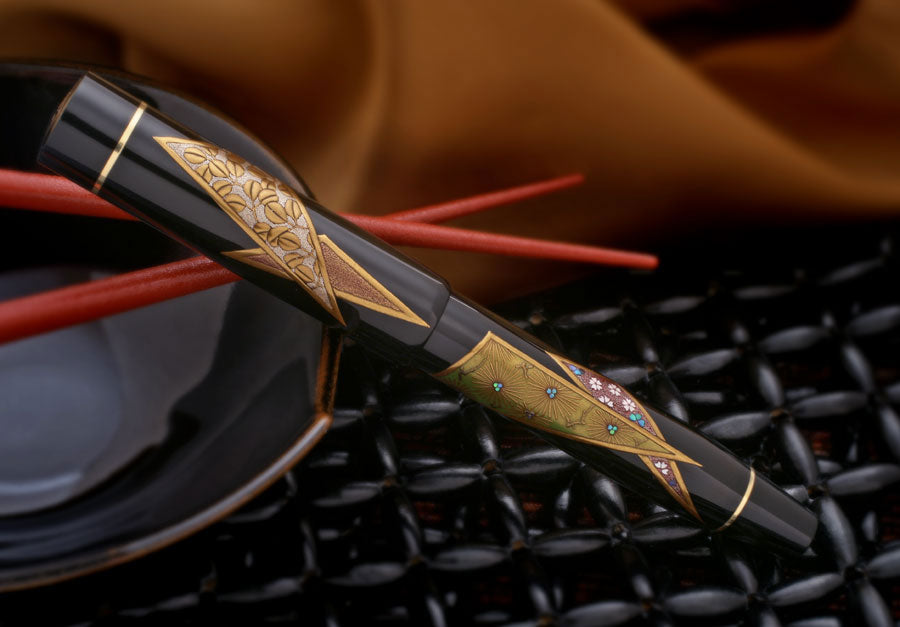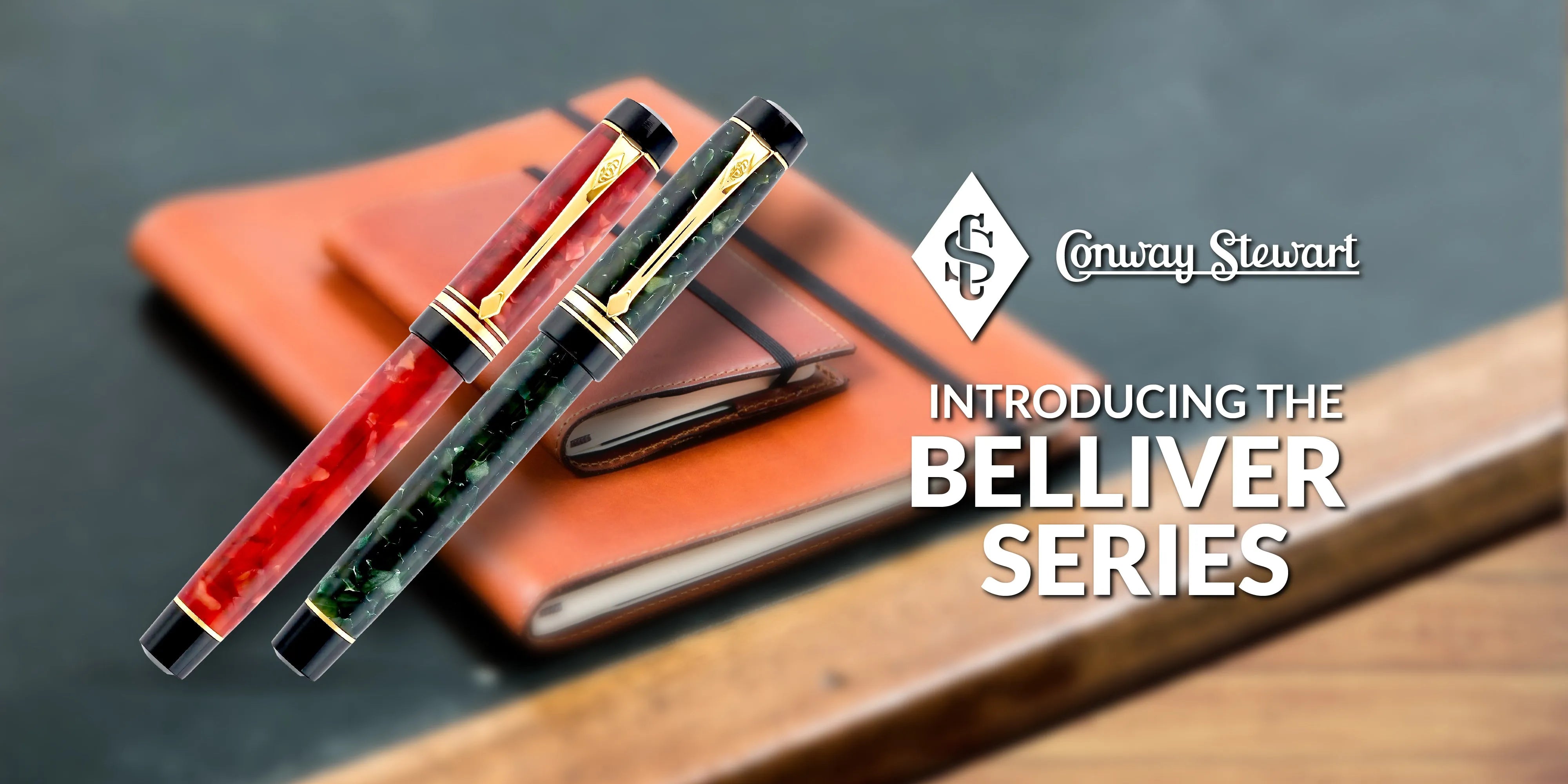The beauty of Maki-e depends on the craftsman's skills: artistic design, knowledge of traditional techniques, and the ability to tell a story through the application of art. Many sought-after artisans acquire their training in their early teenage years, following in the footsteps of their parents and grandparents. A Maki-e artist's vocation is not motivated by money, but by the pride in following a family tradition.
Mr. Koichiro Okazaki's work name is Kogaku-san. He drew his inspiration for the design of the Soka Monyo from flowers throughout the season: sakura, wisteria and Japanese larch. They are displayed within geometric shapes, bordered in thick gold, using the striking contrast of black for the background.
The Floral Design showcases a wide range of many different methods of Maki-e art and techniques used on this bold and striking work. Tsukegaki technique (fine raised lines of lacquer, dusted with gold powder, mostly used for wave patterns), togidashi maki-e (a labor-intensive technique that results in a design completely flush with the surface, utilizing the repetition of paintings, powder sprinkling, and burnishing), taka maki-e (many thin layers of genuine urushi lacquer, with sabi, charcoal or tin powders applied over one another to create slightly raised portions), kakiwari technique (the design is left in reverse in order to reveal the underlying layer of lacquer, particularly useful for fine details such as the veining of a leaf), hira maki-e (design is drawn onto the urushi surface and, using powder sprinkling tools such as cotton, crane quills and bamboo in various sizes gold powder is sprinkled over the lacquer. The design is polished once the urushi has hardened), and shishiai maki-e (the mixed use of taka and togidashi methods).
The sakura is a well-known symbol of Japan and is the unofficial national flower. The cherry blossoms are a lasting symbol for the brief nature of life, and as such are frequently depicted in art. The cherry blossoms symbolize of a bright future. Also, their delicacy suggests purity, transience, melancholy, and it also has poetic appeal.
The Japanese follow the sakura zensen (sakura front), or cherry-blossom front on an annual basis. In Japan, nightly weather forecasts include reports on the advance as the blossoms sweep north. The blossoming begins in Okinawa in February, and typically reaches Kyoto and Tokyo in late March or early April. Then it proceeds north, arriving in Hokkaido a few weeks later. Japanese pay close attention to these forecasts, going to parks, shrines, and temples with family and friends and holding a "flower viewing party." Hanami (flower viewing) festivals celebrate the beauty of sakura, and for many, it is a chance to relax and enjoy the beautiful view. In cities, viewing cherry blossoms in the evening (yozakura) is also popular. Against the dark sky, the cherry blossoms in full bloom are especially beautiful.
In 1912, Japan gave 3,000 sakura trees to the United States and, in 1956, provided an additional 3,800 trees to celebrate the friendship between the two countries. These trees can be seen in West Potomac Park, Washington, D.C. and have become a popular tourist attraction, especially during the annual National Cherry Blossom Festival when they reach full bloom in early spring.
Most Japanese schools and public buildings have sakura trees as part of the landscaping. Since the fiscal and school year both begin in April, in many parts of Honshu, the first day of work or school will coincide with the cherry blossom season.
The Japanese wisteria (wisteria floribunda) is a woody climbing vine that lives more than 50 years. The plant was brought from Japan to the United States in 1860 by George Rogers Hall. Since then, it has become one of the most highly romanticized flowering garden plants as well as being widely used in the art of bonsai.
The flowering habit of Japanese wisteria is spectacular. It bursts into great trails of clustered white, violet, or blue flowers in early- to mid-spring and carries a distinctive fragrance similar to that of grapes.
Japanese larch grows in the mountains of the Chubu and Kanto regions in central Honshu. A coniferous tree with needle-like leaves that turn bright yellow to orange before they fall in the autumn, it shows bare pinkish-brown shoots until the next spring. It is an important tree in forestry plantations, being grown throughout central and northern Japan, and also widely in northern Europe, particularly the British Isles.
The Soka Monyo is a wonderful symphony of art utilizing abstract designs to emphasize nature's colors. In today's modern living it is all too easy to get caught up in the hassle and bustle of life and work. We often forget to take a step aside to appreciate the strength of Mother Nature and the balance of harmony.
ARCHIVE
Soka Monyo (Floral Design), 2007
Maki-e Collection
"Nominee in the 2007 Pen World Reader's Choice Awards -- Best Maki-e"










Archive Blog Posts
WES Journal edition #126, Winter 2023
Spotlight on Conway Stewart Originally published in WES Journal 126, pp 26-29, 2023
The History of Conway Stewart
The Beginning In 1905, Mr. Frank Jarvis and Mr. Tommy Garner formed Conway Stewart & Co. Limited at 13 Paternoster Row LondonEC1, next to St Paul’s Cathedral in London. Today,...
Conway Stewart 'Babbage'
Charles Babbage is popularly known as the “Father of Computing” for his pioneering work with computing machines. The use of Jacquard punch cards, chains and subassemblies, and the logical structure...
Conway Stewart Evergreen Sterling Silver Duro Special Edition
SOLD OUT! Retail List Price Fountain Pen or Roller Ball — £599 $970 €630 Welcome to our February 2010 Special Edition — the Conway Stewart Evergreen. Based on our popular Sterling Silver Duro model,...
The Balmoral
Following the success of our Windsor, which was inspired by the ornate decoration gracing the creations of English gunsmiths, Conway Stewart is pleased to announce the second in this prestigious...
Conway Stewart Cavendish Edition
Conway Stewart is proud to announce our new model in English hallmarked solid sterling silver, the Cavendish. A bold stylish design that brings together a traditional shape with a crisp...
Conway Stewart 'Elizabeth Garrett Anderson' Limited Edition
Elizabeth Garrett Anderson is regarded as England’s first female doctor; a pioneer in educating women in medicine; a strong supporter of women’s suffrage and opportunities in higher education, as well...
The Wellington Series
Arthur Wesley was born in Dublin in 1769. In 1798, his aristocratic Anglo-Irish family changed their name to Wellesley. In honour of Sir Arthur Wellesley, Conway Stewart commemorates the Duke...
Professional Series - Doctor's & Lawyer's Edition
The new Conway Stewart Professional Series is designed to reflect the dedication and life’s work of individual professional fields. These striking new designs are crafted of gleaming black resin and...
Kipling 'IF' Special Edition
The new Special Edition from Conway Stewart is inspired by one of the most important literary figures in English history. At first glance this pen looks like it has a...
Conway Stewart Belliver Series
The new Belliver model from Conway Stewart is a return to the finest traditions of CS heritage, rooted in attention to detail, a perfect size and weight, as well as...
Conway Stewart Montague and Capulet Series II
The 2013 Montague and Capulet series from Conway Stewart celebrates the principal characters of Shakespeare’s eternal classic Romeo and Juliet, bringing a graceful and elegant slim design to life in...
Excalibur Limited Edition
Conway Stewart is pleased to announce the latest new colour on the popular Churchill model — Excalibur with hallmarked solid sterling silver trim. The Churchill Excalibur hand made resin consists of a...
Conway Stewart Edwardian Limited Edition
Conway Stewart is proud to present our new limited edition sterling silver series, ‘The Edwardian’. Based on our popular Belgravia model, the Edwardian is completely crafted from solid sterling silver...
Conway Stewart Gatsby Limited Edition
“Nominee in the 2014 Pen World Reader’s Choice Awards — Best Cultural or Historical Theme” During the classic era of the 1920s, a fine fountain pen was considered not just a luxury,...
60th Anniversary 100 Series Special Edition - Pistachio
60th Anniversary Celebration! The 100 Series was first launched in 1954 and was quick to become one of the most popular Oversize pens ever made by Conway Stewart. In celebration...
Marlborough Vintage Limited Edition Pens
The Conway Stewart Marlborough Vintage Limited Edition is a distinguished new design, that is inspired by the classic styling of our vintage models and created with our present day manufacturing...
Jaguar Limited Edition
The Conway Stewart Jaguar is a new finish to compliment our sold out Elegance Aztec limited edition. Each pen from the Elegance range has a unique design and is produced...
Conway Stewart Collectors Club - Celebration Pen & Book Special
Offered only to members of our Collectors Club, Conway Stewart is making available the Celebration pens accompanied by a hardback copy of the new book, Fountain Pens for the Million — The...
Conway Stewart Collectors Club - Churchill Carbon Fibre
Conway Stewart is making available exclusively to members of the Collectors Club our award-winning Churchill model with hand wrapped Carbon Fibre overlay covering the cap and barrel. Each pen is...




















Leave a comment